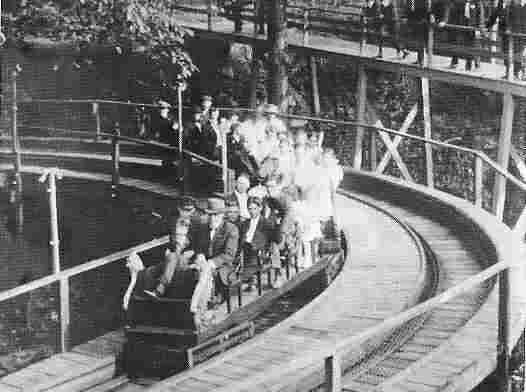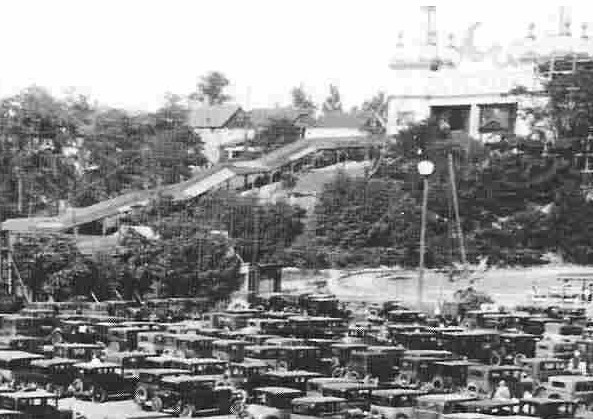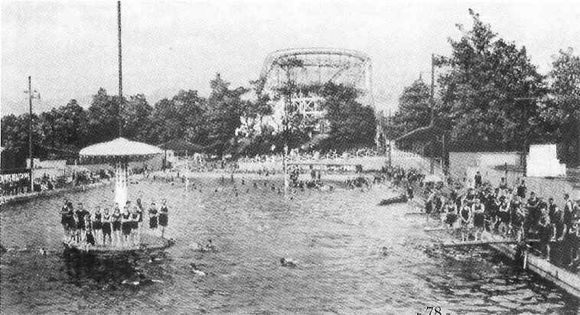Later Improvements to Luna Park
Luna was constantly remaking itself to stay fresh, both changing its shows and installing new cutting edge rides.
Players dedicated to building recreations may wish to play the scenario by modeling some of the improvements and changes made to the park.
1906 - Building the park continues
The park office was moved from its original location next to EDISONIA to a new building next to the entrance archway (between the archway and the Japanese Exposition), and the vacated room would host the Infant Incubators. It may sound weird to our ears, but this was an actual hospital run by a doctor to incubate pre-mature babies. At the time, the medical community did not yet embrace the procedure, so babies were brought to facilities such as this in amusement parks. For a small fee you could watch the infants being treated, http://www.neonatology.org/classics/panam.html !
The concert shell was only located behind the bridge for the parks first year. It was relocated (along with the Circus Ring) into a newly constructed Concert Garden at the rear of the park by Woodland Avenue. The Concert Garden contained hundreds of bistro tables, and sat between the shrunken picnic grounds and the piers supporting the Chutes ramp. The Concert Garden became so popular that it was soon expanded and renamed the German Village (the Night and Morning theatre was gutted, and the facade became the entrance gate to the village).
The Aerial Swing circle swing ride was moved to the spot where the free Circus Ring was located.
Where the swing had stood was built a large octagonal carousel building. [TRIVIA: The original carousel was a T.M. Harton Company "menagerie" carved by Daniel Muller. The original carosel building was replaced in 1915 by PTC #35. Originally music was provided by a French Gavioli & Company forty-five piece mechanical band organ imported by New York’s Berni Organ Company. When Luna closed, PTC #35 was sold to Puritas Springs Park on Cleveland’s West Side, and eventually ended up at Six Flags Over Mid-America, Eureka, Missouri. The carousel has been meticulously restored and can be ridden to this day, http://history.amusement-parks.com/sfstlcarousel.htm].
In 1906 the Japanese styled entrance to the new ridge-running Scenic Railway roller coaster was built, located by the Japanese Exposition.

Extending from the Japanese Exhibition was a suspension bridge to the bottom of the ravine that divided the Luna Park property (the Scenic Railway would later pass underneath it).
From 1906 onwards air shows were regularly performed in the empty field (yes… 1906!). Even the best natural aviator in history, Lincoln Beachey, performed a Luna. This shouldn’t be too surprising however, as Cleveland was always at the forefront of aviation, being home to the Martin Bomber Company (builder of enormous Great War biplane bombers) and host to the Thompson Trophy air races. In fact, even though air racing had to be suspended years ago due to safety concerns, Cleveland still hosts numerous aviation spectacles. Years later some of the parks roller coasters would extend into the field across the ravine.
A large Hippodrome was built behind the Electric Theater where spectacles of circus elephants and wild-west shows were performed (the entrance was reached via a short path under a large sign between the theatre and the Chutes ramp). In later years, everything behind the towered façade would be demolished and a massive roller rink built in their place (the twin towered facade becoming refashioned into the rinks plain looking single towered entrance).
1907 and beyond
In 1907 a second, street level entrance (serviced by the Woodland Avenue Streetcar) would be built on the roller coaster side of the Picnic Pavilion, so people could enter the park without having to climb the entrance stairs on Ingersoll Road.
Eventually the Picnic Pavilion was replaced by a massive first-run movie theater (the Scenitorium had become too small for the purpose) that filled a large portion of the former picnic grounds (by then picnics were mostly held at the bottom of the ravine near the swimming facility).
The Scenitorium Theater proved to be too small, and a larger one was later built in the former picnic grounds at the back of the park (in 1914 the adjoining tower was removed and the old Scenitorium building converted into the Hilarity Hall fun house).
In 1907 the center of the midway at the base of the lagoon hosted the Rainbow Dips, an early "magic carpet" style ride. The land around the lagoon became, over time, a concentration of small stalls and covered walkways.
The buildings on the Café side of the main midway were converted over the years into new entertainments such as the 1910 Human Dry Cleaner ride, a pool hall, and numerous fun houses such as 1915’s Cave of the Winds, and Belfry for Bats (considered to have been Luna’s best). Even the ever popular Shooting Gallery was eventually given a larger building next door to its original location.
In 1912, the corner of Woodland Avenue and Woodhill Road would be the location of the Motodrome, a large stadium built specifically to host the one-year-old (1911) sport of professional motorcycle racing (in later years it would be converted into the home stadium of the John Carroll University football team).
In later years Luna developed the lower property. Improvements included damning the creek above the parking lot (the one inside the billboarded fence) in 1914 to build a swimming beach with wave making machine (yes… wave making!).

 d
d
The 1915 PTC designed Jack Rabbit (PTC #19) would extend along Woodland Avenue, replacing the old wooden side friction Figure Eight coaster. It traveled directly over the rides out buildings (the small wooded area to the left of the coaster was a pony ride track).
The shoe and the fun house would be replaced by a large Ferris wheel in 1916 (at which time the smaller 1907 Ferris wheel located elsewhere in the park was dismantled). [TRIVIA: The 1916 Ferris wheel was custom built by the Walter P. Shaw Company and rose 123 feet above the concrete midway. It supported twelve enclosed cars, each capable of holding a dozen or more people. At the time of its construction, Cleveland’s Luna Park Ferris wheel was the largest operating Ferris wheel in the United States].
Luna Park became so popular that the dance hall became too small to host the crowds. In 1917 the old ballroom called the Casino was demolished and replaced with a Japanese styled 18,000 square foot facility (at the whopping cost of $100,000 dollars).
The Rainbow Dips ride proved difficult to maintain, and was replaced in 1918 by a Whip. [TRIVIA: William Mangles was so proud of the Whip installation at Cleveland’s Luna Park that he included it as the example photo in his ride catalog].
The 1922 John A. Miller designed Pippin roller coaster would replace the Scenic Railway.
In front of the Frerris wheel a Dodgem (bumper cars) was also built in 1922.
When the Pippin was built, the Japanese Exhibition was removed, and beside the Pippin in 1923 was installed one of the very first Hyla Maynes’ Caterpillar rides.
In 1925 Luna removed the Café and installed in its place one of Harry Travers’ earliest Tumble Bug rides (Luna called theirs the June Bug).